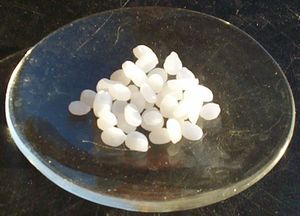Sodium Hydroxide
Sodium hydroxide in household products, Industrial uses of sodium hydroxide

Sodium hydroxide, NaOH, also known as lye or caustic soda, is an extremely caustic (corrosive and damaging to human tissue) white solid that readily dissolves in water. Sodium hydroxide is used in the manufacture of soaps, rayon, and paper, in petroleum refining, and in homes as drain cleaners and oven cleaners. Sodium hydroxide is one of the strongest bases commonly used in industry. Solutions of sodium hydroxide in water are at the upper limit (most basic) of the pH scale. Sodium hydroxide is made by the electrolysis (passing an electric current through a solution) of solutions of sodium chloride (table salt) to produce sodium hydroxide and chlorine gas.
Two of the more common household products containing sodium hydroxide are drain cleaners and oven cleaners. When most pipes are clogged it is with a combination of fats and grease. Cleaners that contain sodium hydroxide (either as a solid or already dissolved in water) convert the fats to soap, which dissolves in water. In addition, when sodium hydroxide dissolves in water a great deal of heat is given off. This heat helps to melt the clog. Sodium hydroxide is very damaging to human tissue (especially eyes). If a large amount of solid drain cleaner is added to a clogged drain, the heat produced can actually boil the water, leading to a splash in the eyes of a solution caustic enough to cause blindness. Some drain cleaners also contain small pieces of aluminum metal. Aluminum reacts with sodium hydroxide in water to produce hydrogen gas. The bubbles of hydrogen gas help to agitate the mixture, helping to dislodge the clog.
Oven cleaners work by converting built up grease (fats and oils) into soap, which can then be dissolved and wiped off with a wet sponge.
Sodium hydroxide is used to neutralize acids and as a source of sodium ions for reactions that produce other sodium compounds. In petroleum refining it is used to neutralize and remove acids. The reaction of cellulose with sodium hydroxide is a key step in the manufacturing of rayon and cellophane.
Resources
Periodicals
"Corticosteroids Can't Counter Caustics," Science News vol. 138, p. 174, Sept. 15, 1990. "How Lye is Made and Some Uses," Countryside and Small Stock Journal Vol. 78, p. 37, March-April 1994.
Louis Gotlib
Additional topics
- Sodium Hypochlorite
- Sodium Chloride - Bonds, Location And Processing, Mining, Evaporation, Uses - Properties
- Sodium Hydroxide - Sodium Hydroxide In Household Products
- Other Free Encyclopedias
Science EncyclopediaScience & Philosophy: Adam Smith Biography to Spectroscopic binary